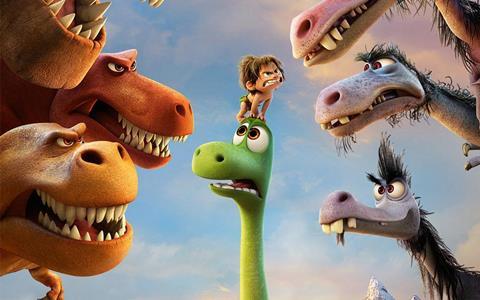The Good Dinosaur director Peter Sohn talks to Elbert Wyche about bringing a friendly dinosaur and a dog-like boy to life and hatching the film’s environment from present-day reality

Disney/Pixar’s The Good Dinosaur began as the simple story of a boy and his dog. In this case, the boy is an 11-year-old apatosaurus called Arlo, and the canine-like friend is Spot, a human boy whose species has not yet attained the ability to speak.
The design of Arlo created a unique set of challenges for The Good Dinosaur’s director Peter Sohn and his creative team. Sohn wanted the audience to see and feel Arlo’s youth in order to relate to him, and fear for his safety in the harrowing circumstances he faces throughout the film.
“We wanted to make Arlo empathetic so you could feel he might not be able to survive out in the wilderness,” Sohn says.
“We pushed Arlo’s size to feel a little bit smaller; a little runtier. We pushed his knee design and his leg design to feel like an awkward growing teen. In Arlo’s face we wanted a softer appeal and bigger eyes.”
Arlo’s eyes not only needed to convey youth, they needed to be expressive enough to communicate with his human companion Spot.
“Spot was interesting because we really wanted to find that kid that has been out on his own for a while,” says Sohn.
“A boy that was tenacious and brave but who also had a vulnerable innocence to him, so that when we needed to get to the core of him, you could empathise with his human side.”
Spot was designed to walk on all fours so his canine quality would be emphasised. Because of his inability to speak, Spot’s facial expressions and movements had to be exaggerated. He also lives in the wilderness, so his appearance had to be filthy and dishevelled.
Sohn modelled the character’s hair on his own daughter, “because every morning when she wakes up she has this kind of look, like: ‘Boy, did you sleep out in the barn? What is this look?’”
Research trips to Wyoming, Oregon and Idaho inspired the design of the film’s environment. Nature itself played the part of both protagonist and antagonist in the film.
“It could be both beautiful and dangerous,” Sohn says. “The whole fun about dinosaurs is how big they are but then what’s bigger than a dinosaur? Mother Nature was that character.”
The animation team experimented initially with a more stylised forest but the result, Sohn says, “took the threatening quality out; it didn’t feel like Arlo could die out there”.
It was important that the world of the film feel big, but more importantly it had to feel real. The animators used Google relief maps that contained geological and topographical information, which led to realistic world building.
“We got all of this USGS [US Geological Survey] data and layered in all the grass, the trees and the billions of leaves on that,” says Sohn. “We placed the river on top of that geographical data, then we would push and pull where we needed for the story.”
The result is a vast world that becomes a visceral and immersive stage for Spot and Arlo on their journey home.
























No comments yet